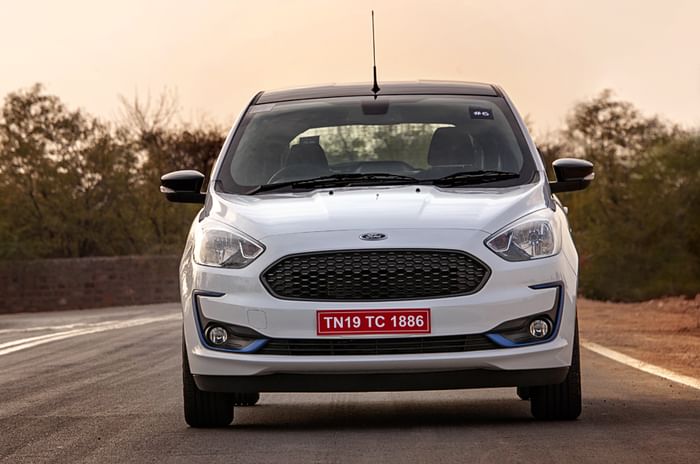2019 Ford Figo facelift review, test drive
With over 1,200 new parts, the updated Ford Figo promises to be quite an improvement over the outgoing model. Is it so? And is the Figo ready to take its competition head-on?
Published on Mar 17, 2019 12:00:00 PM
1,29,254 Views
Follow us on



What is it?
The much-awaited update of Ford’s hatchback gets a number of changes inside out and also gets a new set of petrol engines. The car you see here is the top-of-the-line Titanium Blu variant, which gets a sportier-looking, all-black grille in what Ford calls a ‘cellular’ design and C-shaped fog lamp housings with blue accents. The black roof and black 15-inch alloy wheels are a nice contrast to the body colour and make it stand out in the crowd. There are very few changes to the rear; the Ford Figo facelift gets a redesigned bumper, and there’s no escaping the fact that the Titanium Blu variant looks much like the previous Figo's Sports Edition, which was launched in 2017. However, the small details to the design do well to differentiate it from the previous car. It’s also worth noting that the lesser Titanium trim doesn’t get the contrast roof, sticks with 14-inch alloys and all those black and blue accents are chrome instead, just like on the Aspire sedan. The equipment list has also been updated, with the biggest addition being a 7.0-inch touchscreen.

The powertrain options are the same as in the updated Aspire. The 96hp, 1.2-litre, three-cylinder ‘Dragon’ engine replaces the older 88hp, 1.2-litre, four-cylinder unit. The new engine not only has more power, but Ford also claims it is more efficient by 2.24kpl. The older 110 hp, 1.5-litre petrol with its dual-clutch automatic has been replaced by a new 123hp, 1.5-litre petrol and its 6-speed torque-converter automatic from the EcoSport. Ford’s much-loved 100hp, 1.5-litre diesel engine has been carried forward, but with a new 5-speed manual gearbox.
What’s it like on the inside?
Not much has changed inside, and you’re still greeted by an all-black theme. There are piano black finishes on the centre console and steering wheel, which add a bit of upmarket feel, the dials now get a carbon fibre-like finish, which improves the look, but they still feel a bit too small. The overall fit and finish might not be class-best, but it does feel built to last. There are plenty of storage places in the cabin for the front passengers, with huge door pockets, a big glovebox and multiple stowage areas between the seats.

Those front seats of the Titanium Blu variant get contrast blue stitching, which lends a sporty look. The cushioning is on point and the long seat base provides good under-thigh support. The side bolstering is also adequate and helps keep you in place while on bends. Overall visibility from the driver’s seat is good, and despite the fact the outside mirrors are tiny, the view they offer isn't bad at all. In the back seat, there’s adequate legroom, thanks to the scooped-in backs of the front seats, and just like at the front, the long seat base provides good under-thigh support. The bench, however, is flat, the backrest is set upright and tall passengers will find the headroom to be tight. You still don’t get door pockets or a centre armrest, but Ford has listened to customer feedback and provided adjustable headrests. The boot space is a decent 257 litres, but the loading lip is high and the boot floor is low, so loading big bags will require some effort.

On the equipment front, the Figo remains quite well equipped, with auto climate control, power-folding mirrors, an auto-dimming rear-view mirror, auto headlamps and auto wipers. But now you have a much-needed touchscreen, a 7.0-inch unit, available in the mid-spec and top-end variants. However, it doesn’t get Ford’s class-leading Sync 3 operating system (available on the top-end Aspire) and hence misses out on Android Auto and Apple CarPlay connectivity. Instead, it’s a simpler unit with embedded navigation, and there is, of course, USB, aux and Bluetooth connectivity.
What’s it like to drive?
Of the three powertrain options, we got to sample both the manuals. The new 1.2-litre, three-cylinder, naturally aspirated petrol engine makes 96hp and 120Nm of torque and is mated to a new Getrag-sourced 5-speed manual gearbox, which was first seen in the Freestyle. With a light clutch operation, getting off the line is a smooth affair, and the engine is very refined too. The engine’s performance at low speeds, however, is not that exciting. It is not that responsive below 2,500 rpm, and therefore you’ll find yourself working the gearbox more than usual. Luckily, the gearbox has short throws and is easy to slot. The real power comes in after the 2,500 mark and, here onward, the engine delivers strong and linear performance. There is good power even in the top end, all the way until the 6,800rpm redline. The engine does get noisy as you climb the rev range, but the engine note is nice and suits the hatchback’s sporty nature more than it does the Aspire sedan.

The 100hp, 215Nm, 1.5 diesel has always impressed us, and it did again with this new 5-speed gearbox (it’s the same unit as in the petrol, but with different ratios) when we sampled it in the Aspire and Freestyle. There is a small amount of turbo lag at low speeds, but it’s very well masked. And once the turbo kicks in at 1,700 rpm, you get a strong surge of power which is sustained until 4,000rpm. Here, too, the gearbox works much better than the old IB5 unit, with lighter, smoother, more positive shifts that add to the driving pleasure. The taller gearing of the new transmission also makes this diesel version a good cruiser and allows it an ARAI-rated fuel efficiency of 25.5kpl. The clutch, although heavier than in the petrol car, is well weighted and has a consistent feel to it.

Compared to the tremendous first-gen car, the dynamics of the second-generation Figo felt a lot softer and more comfort-oriented. Things were quite different, however, with the 2017 Sports Edition, which handled much better than the regular Figo, thanks to the re-tuned, lower suspension, 15-inch wheels and a beefier anti-roll bar. This facelift gets the bigger wheels and anti-roll bar, and while the suspension has been re-tuned, it hasn’t been lowered. So yes, while the front stays planted in fast cornering, the car is not quite as sharp as the Sports Edition. What it is, instead, is a good halfway point between the sharpness of the Sports Edition and the comfort of the standard, pre-facelift car, which is more suited for everyday driving. The suspension handles bad roads with ease and is silent in operation with only sharp potholes being registered inside the cabin. However, over a patch of bad roads, there is a hint of bobbing which is evident. The steering stays light in the city and weights up nicely as you gain speed on the highways, and through all this, it still offers possibly the sharpest turn-in in the class. This remains the mid-range hatchback of choice if you enjoy driving.
Should you buy one?
Ford has cut down the number of variants from five to just three (Ambiente, Titanium and Titanium Blu) and the prices start from Rs 5.15 lakh for the base 1.2 petrol, going up to Rs 7.74 lakh for the top-end diesel Titanium Blu. The 1.5 automatic is available only in the mid-spec Titanium variant for Rs 8.09 lakh (all prices, ex-showroom India). That works out to an average of Rs 40,000 less, variant for variant, compared to the earlier Figo!
The Freestyle, launched almost a year before, showed us pretty much exactly what we would be getting with this Figo facelift, so it wasn’t much of a surprise. But then that’s no bad thing, because the Figo comes together as an excellent all-round package. We just wished the top equipment level – 6 airbags, auto lamps and wipers etc – wasn’t restricted to the ‘Blu’ styling package because the racy decals and black accents might not be to everyone’s taste.

The equipment upgrades are welcome, but also necessary amidst aggressive competition, but we really wish they’d have sprung for the higher-spec infotainment unit with Android Auto and Apple Carplay, which has quickly become the norm for cars with touchscreens. The new petrol engine (and the accompanying gearbox) does its best work in this hatchback, where you’ll be more inclined to wring it out and get the best out of it. The diesel, as ever, is an absolute gem.
So, while the Figo has been updated, the proposition hasn’t changed. It still remains the one to pick if you enjoy driving, with strong engines and excellent dynamics. What’s more, you’ll get a lot more peace of mind now, as Ford has pushed towards highly competitive ownership costs and offers a 5-year extended warranty. And all this, at a more affordable price.
Also see:
2019 Ford Figo facelift vs rivals: Price, specifications comparison
Tech Specs 
Copyright (c) Autocar India. All rights reserved.






 Price
Price Engine
Engine Transmission
Transmission Efficiency
Efficiency Body
Body Suspension
Suspension Steering
Steering Brakes
Brakes Dimensions
Dimensions
Comments
Member Login
Personal Details
No comments yet. Be the first to comment.